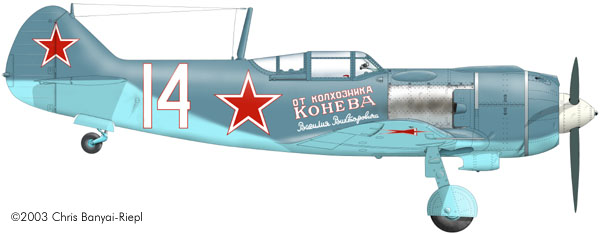The Lavochkin La-5 Family | | The Lavochkin La-5 family was created through the merging of the inline LaGG-3 airframe with a radial engine, and the resulting aircraft went on to become one of the most successful fighter designs of the Second World War. Below are a few illustrations of this famous fighter. 
La-5, White 15, Museum of Defense of Leningrad, 1945.
The most commonly seen photos of this plane show it in the Museum of
Defense of Leningrad in 1945. It has been re-painted in a manner not
authentic to its wartime appearance, the colors being A-24m green over
AMT-7 blue. While the upper surface color is wrong, the detail in the
mouth is quite precise. The Guards badge under the cockpit is modified
from the original, as it features the word ‘Slava’ (Glory)
in the flag instead of the actual ‘Gvardiya’.
PROFILE ERRORS: This profile has several errors in it,
as it was created before full information on it was received. The spinner
and rudder should actually be white, and the white outline of the tail
star should have a thin red outline over the white rudder. Also, as
this was an example in a museum, all traces of exhaust staining are
gone, and the metal exhaust plate should be painted over in green.


La-5F, White 14, 240 IAP, spring 1944, Yassy, Pilot Ivan
Kozhedub.
Originally finished in AMT colors, Kozhedub’s White 14 was painted
over the entire upper surfaces with Wood Aerolak.

La-5FN, White 52, 322 IAD, Pilot N. Pushkin.
Finish is AMT-11/12 over AMT-7, while the spinner is red and the front
end of the cowling in yellow. The inscription, Mongol’ski Arat,
means “Mongol Warrior”, and adorned many of this Division’s
aircraft. This machine is probably from the 2 GIAP, as were many ‘Mongols’,
but not all of them.


La-5FN, White 185, unknown unit, location and pilot.
Finish is AMT-11/12 over AMT-7 and is quite worn. The AMT-12 under the
cockpit in particular is heavily worn down. There are four white stripes
on the tail. The worn appearance and high number suggest that this plane
was part of a training unit, but no evidence proves that one way or
another.
| 









|















